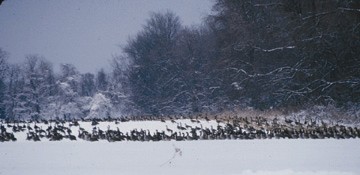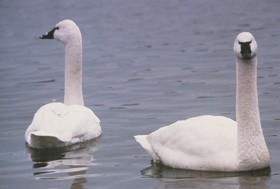A Winter Retreat for Waterfowl
By Kathy Reshetioloff

As cold Arctic blasts move down upon us, the skies erupt with the songs of waterfowl migrating to wintering grounds. Swans, geese and ducks seek out the rivers, creeks and wetlands of the Chesapeake Bay for food critical to their survival. In winter, waterfowl may eat up to their own body weight each day.
About 1 million waterfowl winter on the Bay between October and April. This is roughly one third of all waterfowl wintering along the Atlantic Coast. The Chesapeake Bay's more than 11,600 miles of shoreline, including major rivers and 200,000 acres of coastal marshes, lure birds from Alaska, Canada, north central United States and New England.
Swans are the largest of waterfowl and the tundra swan travels the farthest, more than 4,000 miles, to winter primarily on the Eastern Shore. These large white birds are easily recognized by their black bills and straight necks. Tundra swans often flock together on shallow ponds. Another is the mute swan, an invasive, nonnative bird from Europe that competes with other waterfowl for food and habitat. Orange bills and s-shaped necks distinguish the invading mute swan from our native tundra swan.
 Constant honking signals the arrival of the familiar Canada goose, with its black and white head, brown back and pale breast. A favorite quarry of hunters and bird watchers, Canada geese feed in wetlands and farm fields. A lesser known visitor, the snow goose, is almost completely white except for black wing tips and pink feet and bills. Constant honking signals the arrival of the familiar Canada goose, with its black and white head, brown back and pale breast. A favorite quarry of hunters and bird watchers, Canada geese feed in wetlands and farm fields. A lesser known visitor, the snow goose, is almost completely white except for black wing tips and pink feet and bills.
Ducks are divided according to their method of feeding: dabbling and diving. Dabbling ducks feed by straining food from the water's surface or by submerging their heads while their tails remain out of the water. Characteristics common to dabbling ducks include legs positioned toward the middle of the body and colored wing patches. Males are usually brightly colored and females drab. Dabblers take flight by leaping from the surface of the water and can be found on rivers and close to shorelines. Plants make up most dabblers' diets.
The most common of the dabblers is the mallard duck. The male has a dark green head while the female is dusky brown. Another dabbler is the black duck. Both male and female black ducks look similar to mallard hens, only darker. These two species often interbreed. Other dabblers include the American widgeon, green-winged teal, northern pintail (male has long black tail feathers), and northern shoveler (named for its large spatula-like bill).
Diving ducks have legs located to the rear of the body. This makes walking on land difficult. Diving ducks swim underwater, pursuing fish or searching the bottom for roots and seeds of bay grasses and small animals. They run along the surface of the water to take flight. Diving ducks can be further separated into bay, sea and river ducks.
Bay ducks feed in shallow water, foraging for both plants and animals. Males have contrasting head and body colors while the females are dark or brown. The most famous is the canvasback, with its sloping black bill, red eyes and head, and white back. Canvasbacks congregate on the water in large flocks known as rafts. Redhead ducks are similar to canvasbacks, but with shorter bills and round heads. Feeding solely on submerged aquatic vegetation (SAV), red head ducks were once abundant on the Chesapeake Bay. Today, more redheads winter farther south, where plants are more plentiful. Other bay ducks include the greater and lesser scaup.
Sea ducks are commonly found in deeper, open waters of the Bay. Most sea ducks feed primarily on animal foods like crabs, clams and barnacles. The old squaw sports contrasting brown and white colors and long tail feathers. Sloping foreheads identify the white-winged, surf and black scoter. The ruddy duck, like the canvasback, masses in rafts. The bufflehead is a small black and white duck. As its name implies, the male of this duck has an easily identified puffy head.
The three species of river ducks are all mergansers that prey on fish found in fresh and brackish water. Mergansers are identified by long, thin, serrated bills and crested heads. The red-breasted, hooded and common merganser all overwinter in the Chesapeake Bay area.
National Wildlife Refuges (NWR) provide some of the best opportunities to see wintering waterfowl. Eastern Neck NWR., Blackwater NWR or Patuxent NWR are a few of the refuges within driving distance from Annapolis. For more information about National Wildlife Refuges and waterfowl production areas, call (800) 344-9453 or visit http://refuges.fws.gov.
Back
|

